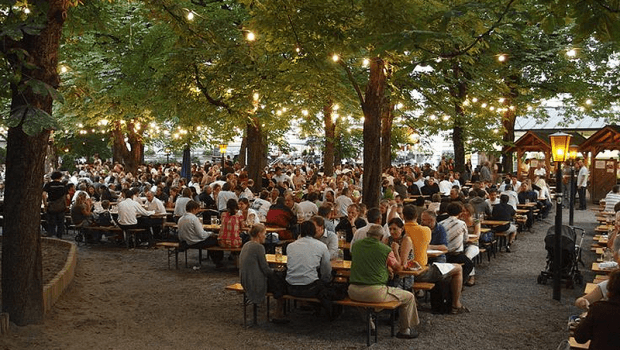
Biergarten: Savory Drinks, Food, Greenery and More
Biergarten is German for a beer garden. It is an expanse of the area out of doors where beer and local food, often traditional German delicacies are served. Meals are shared together with many people in joint tables. Entertainment such as music and games enhances the Gemütlichkeit. There is a sense of belonging, warmth, friendliness and social acceptance associated with the good-natured, cheerful trait of German culture. These gardens are the best place for picnics and making new friends. Beer is a major ingredient of German culinary history. Germany ranked third in a survey of worldwide per capita beer consumption. So it comes to no surprise that beer gardens were established here for the first time. Originating in Munich in Bavaria in the 19th Century, beer garden has survived the years and spread all over the world. Biergartens are usually attached to a restaurant, pub. Beer halls which specialize in making and serving high-quality beer are usually extended to a beer garden. In traditional beer gardens, patrons are invited to bring their own food. Wirtsgarten is sometimes incorrectly considered to be a traditional Biergarten. In a Wirtsgarten a self-servicing facility is absent, and guests cannot bring their own meals. Beer gardens have substantially increased in the 21st century.
History:
In the 16th century, a decree was passed according to which brewing beer was prohibited in the summer months owing to the danger of fire. Therefore beer was only made in the spring season. Higher alcohol content helped preserve it for a longer time through the hot summer months. Beer gardens can be traced back to the 19th century. It started as an extension of German beer breweries. The lager yeast found in Bavaria did not ferment rapidly at warm temperatures as the other variety of ales produced then. Lagers fermented on a cool temperature slowly. After fermentation at a temperature of around 45 to 56 degrees Fahrenheit, it needed to be stored and aged for several months. In that age when refrigerators had not been invented, beer was allowed to ferment while stored in barrels and kept in cellars. As beer is sensitive to heat, the cellars were required to be cool, so chestnut trees were planted to provide shade. It was when the Bavarian King Ludwig granted the right to brewers to sell their brew on the spot from June until September that the beer garden came to be. The Brewers put benches and tables near their cellar in the warm months. Since brewers were initially not allowed to sell food, there was an ample supply of drink in the beer gardens but nothing to eat. As a result, people began to bring food with them in the garden. This custom is still maintained in traditional beer gardens.
The garden near the Augustinerkeller set up in Munich in 1812 after Bavaria’s King Maximilian I consented the establishment of beer gardens is considered the oldest. It is shaded by 100 ancient chestnut trees. A traditional bell-ringing ritual is celebrated whenever a fresh keg is opened. The Chinese Tower with room for 7000 beer drinkers is the second largest beer garden. It is located in the English Garden. Chinese structures and features can be seen. Berlin opened its first beer garden in 1837 in the Prater. With added attributes like theater and other performances the Prater beer garden gave a German tradition an urban touch. The Prater garden can seat 600 guests in summer. There is a beer garden above the cellar of Weltenburg Abbey. Here the brew is pumped directly from the fermentation cellar in the cliff to the tap through a pipeline. The garden lies in the inner courtyard of the abbey. This brewery has been used since 1050. Other German cities have also adopted beer gardens. The local brew of Cologne known as Kölsch is served in Hellers Volksgarten. It is an outdoor tavern located on a small lake surrounded by a park. Dating back to 1891 this venue was a favorite meeting place for the locals.
Munich is the proud host of almost 200 beer gardens. Among the most popular are Hirschgarten, Augustiner Keller, Aumeister, Viktualienmarkt and Hofbräuhaus Biergarten. Other beer gardens in Munich include Brauhaus Bruck, Kloster Andechs Bräustüberl, Weisses Bräuhaus Berg am Laim, Schloss Dachau Biergarten, Max Emanuel Brauerei, Wirtshaus am Bavariapark, Zur Aubinger Einkehr, etc.
Hirschgarten:
A notable beer garden in Munich is the Hirschgarten officially known as Königlicher Hirschgarten. It was established in the year 1791. It is the largest beer garden in Munich and arguably the best in the world. It is located in Neuhausen / Nympenbur beside the recreational deer park. Social and family functions of the celebrated Wittelsbach line used to be held here. The huge park originally was a royal hunting ground of Prince Elector Karl Theodor. Back in 1720 pheasants used to be bred here. Between Nymphenburg Palace and the S-Bahn line lays this garden. The interior restaurant has a capacity of about 500 persons. It has six cozy and beautiful dining rooms with a splendid setting. Sundays and other public holidays offer evening buffet of seasonal and oriental cuisines and a delicious brunch menu.
Over 8000 people can sit and eat here while drinking in the fabulous scenery of Munich. Traditions that are maintained are full-fledged. One can drink Germany’s finest brews including Kaltenberger Bräu, Augustiner and HB Tegernsee here straight from the traditional wooden kegs. High-quality beer is prepared following the specifications and standards of the Purity laws that date back to the 1500s. The colloquial term ‘Hirschen’ refers to the 200-liter wooden casks in which the brew is stored. King Ludwig began the tradition of providing his stag hunting party with 200 liters of beer. Visitors are expected to rinse the mugs in a cold-water basin and putting them on the racks after finishing off the amber liquid. As long as the beverage is purchased from the Biergarten, one can bring their own food from home. Beer mugs can also be provided by the guests. Brotzeit is part of the garden’s tradition. There are five beer stations. Plenty of self-service huts are available serving a delicious array of dishes from snacks to desserts. Waiters serve only the area near the restaurant which is table clothed. The restaurant offers pork dishes, rotisserie chicken, breze or pretzels, Kartoffelsalat, Hendl, spareribs, salads, Obatzda, Weisswurst and a varied selection of homemade cakes. Homemade ice creams are sold in a recently added ice cream stall.
Inviting atmosphere and lip smacking dishes sided with beer favorites make this food joint a must visit venue in a Germany trip. The beer garden has an air of the countryside. The area is constituted by hedges, trees, and parkland. Chestnut trees overshadow most of the tables. The place gets its name from the petting zoo hosting about 30 deer. Also, five outdoor screens are positioned outside around which 4000 to 8000 enthusiasts can watch soccer. There is an old school sign leaning against a tree trunk on behalf of the Hirschgarten hosts which says that food can be brought on their own or bought from the publicans. You can see the traditional Augustiner Brauerei horse-drawn wagon carrying beer. The summer months see the garden filled with people playing football and having barbecue get together. It remains open on all days of the week from 11 A.M. to midnight or later. Kids, as well as adults, have plenty to look forward to a trip to the Hirschgarten. There is ample space for children to enjoy. The wildlife reserve next to it is a grand hit as are the toy stand and the carousel with its attractive prizes to offer. Special occasions such as birthdays, christening and weddings also take place on the grounds.
How to get there?
The easiest way to reach the Hirschgarten is from the train station Laim. In 2010 a new S-Bahn station was opened named “Hirschgarten” owing to the popularity of the beer garden. From the station, it is a fifteen-minute walk. From the city, a convenient way is through the tunnel crossing Winfried Strasse. There are bus stops at Romanplatz or Hirschgartenallee. Parking spaces are available near the Nymphenburg Palace.
Germany and beer go hand in hand. There is no better place to cool off than in neatly placed tables and chairs under the shade of chestnut trees drinking chilled beer from wooden cups. Beer gardens combine refreshment and entertainment with the friendly company in a favorable venue. The immortal culture and tradition of Germany live in these old beer gardens.
